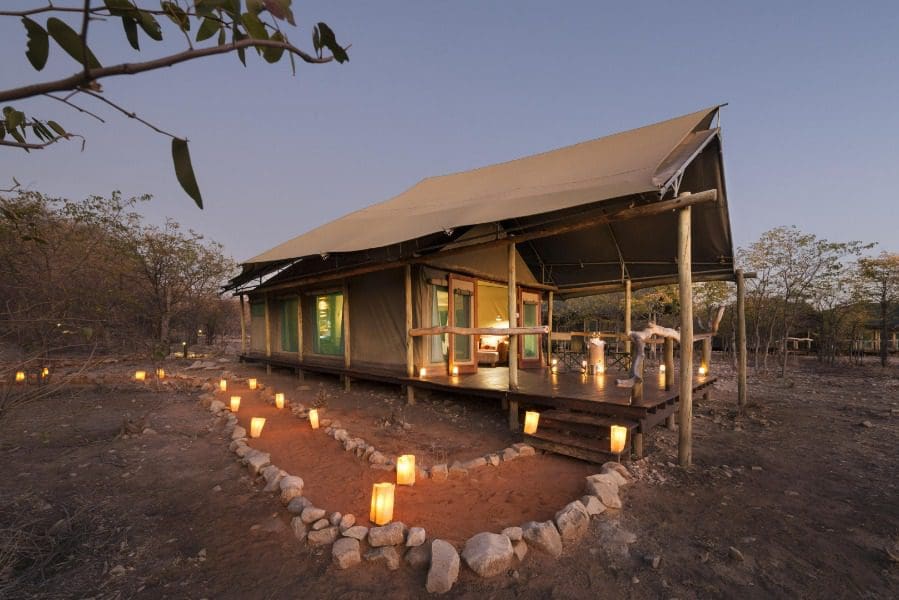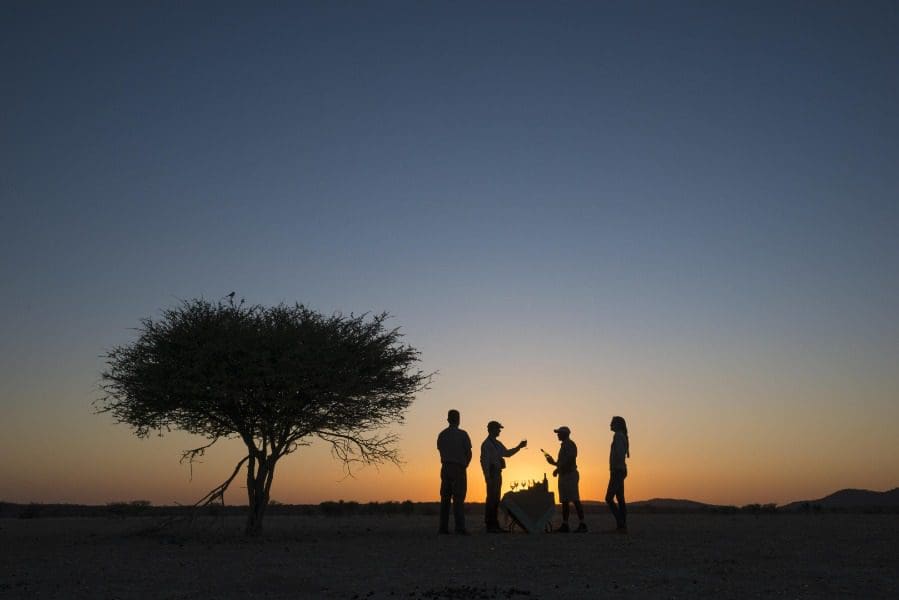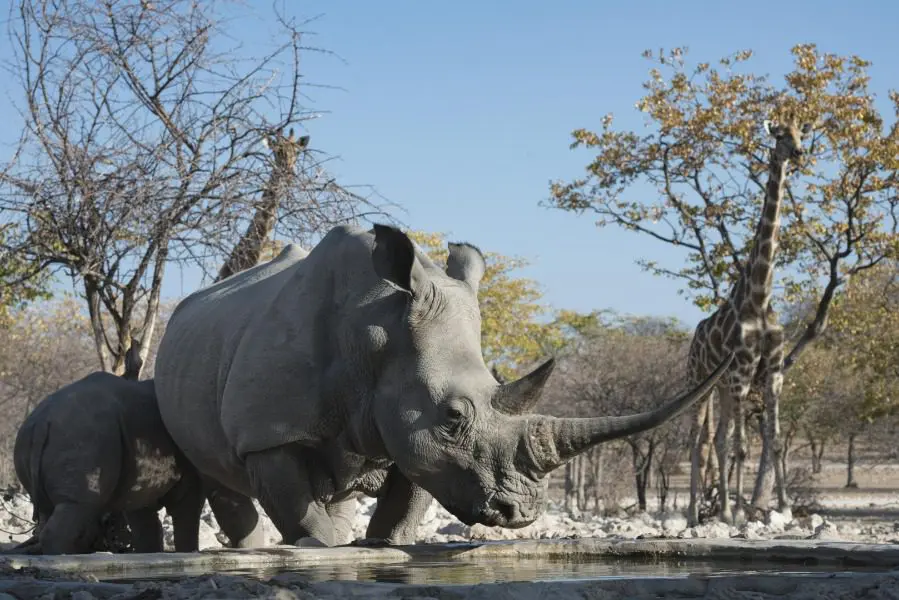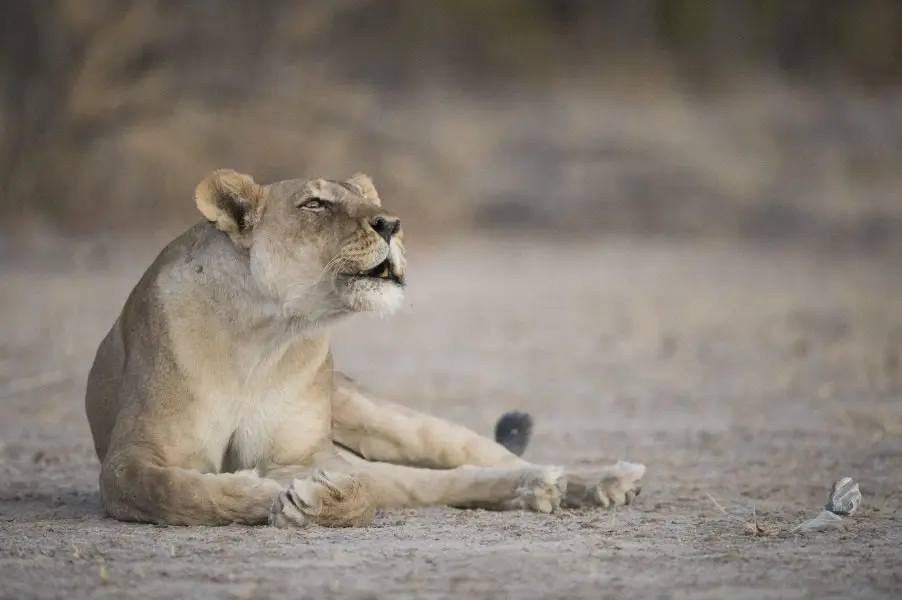Language
- Deutsch
- English
- Español
- Français
- Italiano
- Nederlands
- Português
Currency
- AUD Australian Dollar
- CAD Canadian Dollar
- EUR Euro
- GBP Pound Sterling
- SGD Singapore Dollar
- USD US Dollar
- ZAR Rand

when to go
The dry May to October winter months are widely regarded as the best time to visit Namibia for game viewing – especially in Etosha National Park. The skies are clear, the risk of malaria is at its lowest, and animals are increasingly concentrated around water sources as the dry season wears on. However, prepare for frosty nighttime temperatures in June and July, whereas September and October can be extremely hot. The summer rains between November and April turn the country green and occasionally bring floods to the desert.
| Destination | Jan | Feb | Mar | Apr | May | Jun | Jul | Aug | Sep | Oct | Nov | Dec |
|---|---|---|---|---|---|---|---|---|---|---|---|---|
|
27°C
54mm |
26°C
64mm |
26°C
81mm |
26°C
25mm |
24°C
3mm |
22°C
0mm |
21°C
0mm |
24°C
0mm |
26°C
2mm |
28°C
10mm |
28°C
20mm |
27°C
17mm |
|
|
Fish River Canyon |
33°C
6mm |
33°C
9mm |
31°C
17mm |
29°C
6mm |
25°C
3mm |
23°C
3mm |
22°C
2mm |
24°C
1mm |
26°C
2mm |
29°C
3mm |
31°C
2mm |
33°C
3mm |
|
25°C
6mm |
25°C
8mm |
25°C
13mm |
24°C
4mm |
22°C
2mm |
21°C
3mm |
20°C
1mm |
20°C
1mm |
21°C
1mm |
23°C
1mm |
24°C
2mm |
25°C
1mm |
|
|
35°C
36mm |
34°C
39mm |
32°C
42mm |
29°C
22mm |
24°C
6mm |
21°C
2mm |
22°C
0mm |
24°C
1mm |
28°C
1mm |
31°C
7mm |
34°C
12mm |
35°C
16mm |
|
|
23°C
5mm |
24°C
4mm |
24°C
10mm |
23°C
1mm |
22°C
0mm |
21°C
0mm |
19°C
0mm |
18°C
0mm |
19°C
0mm |
20°C
0mm |
22°C
1mm |
22°C
1mm |
|
|
31°C
75mm |
29°C
92mm |
28°C
84mm |
27°C
33mm |
25°C
6mm |
22°C
2mm |
23°C
0mm |
26°C
1mm |
29°C
3mm |
31°C
12mm |
31°C
28mm |
32°C
31mm |
|
| Dry Season | ||||||||||||
| Wet Season | ||||||||||||
| Best Time for Safari |
Scroll For More

It is mid-summer in January and temperatures in most parts of the country are hot, with some parts experiencing heavy afternoon showers. The summer rains make Etosha National Park green and lush, but wildlife spotting can sometimes be challenging through the dense foliage. Bird watching is especially good this time of year, particularly to see the pink plumes of the flamingo. It's not advisable to travel to the Zambezi Region (previously the Caprivi Strip) during the rainy months, as the area receives the most rainfall in Namibia and roads may be flooded. There is also a higher risk of malaria.
February is the warmest, wettest and most humid month. If you can tolerate the rain, there's plenty to enjoy. The month of February coincides with the calving season in Etosha National Park, and even though it's a tricky time to spot wildlife, you could have the opportunity to see newborn babies.
There is less rainfall in March, but it's still hot and humid in the day with the nights starting to get cooler. March is not the best month for game viewing, but April is the best time to go to Namibia if you are an avid photographer – the skies are clear and nature's canvas beckons.

May is the start of winter and is highly regarded as the best time to go to Namibia, as it marks the start of peak safari season. The conditions are perfect for game drives, with little to no rainfall and a low humidity. This is when wildlife start gathering around watering holes as the rivers and other larger water sources dry up and water becomes scarce.
The nights become colder during June and at times the temperature can drop dramatically, while the desert areas can experience below freezing conditions. During the day, the weather is pleasant with clear, blue skies. With no rainfall, the landscape becomes dry and sparse, making it much easier to spot wildlife while on a luxury safari in Namibia. The game parks are still relatively quiet at the start of the month but can get very busy towards the end of June.

July is by far the driest month of the year and is one of the best times for travelling to Namibia and visiting the game parks, especially Etosha National Park. It's not uncommon during this time to see a huge range of wildlife – elephant, zebra, giraffe, gazelle and wildebeest – in big numbers, all drinking together at one watering hole.
August is the height of winter but is a very popular time for travelling to Namibia, so it's best to book accommodation well in advance. This is an excellent month for wildlife viewing and for outdoor desert activities – the daytime temperatures remain pleasant and mild despite the very cold nights. A highlight in August is the wild spring flowers coming into bloom which creates a beautiful, flowery carpet across the landscape in the Ai-Ais Richtersveld Transfrontier Park.
September is an ideal time for travelling to Namibia on safari. Day time temperatures are pleasant, and the nights begin to warm up. The landscape is still dry during this month, meaning game viewing is excellent.
October marks the last month of Namibia's winter. The weather starts to get warmer and there is a chance of rain, but the skies are generally still clear – perfect for star-gazing and game viewing. October is where to go in Namibia for whale watching on the coast as southern right, minke and humpback whales pass by the Walvis Bay area on their annual Atlantic migration.

The rainy season begins in November, and it becomes cooler across the country. The weather is quite unpredictable during this month, but as the rain makes its way in, you could see some rather impressive thunderstorms. From November to about February, flamingos abound in Swakopmund – bright pink plumes gathering in their thousands around lagoons.
December offers very rewarding game viewing in Etosha National Park with spectacular elephant, lion, rhino and kudu sightings. Summer is the best time to go to Namibia for bird watching, as the migrant birds begin to arrive with the rainy season. This is a very busy time of year with school holidays and the festive season bringing many visitors to Namibia for an end of year safari holiday.
Chat with someone who’s been there. Get in touch with one of our Africa Safari Experts to help tailor-make a trip to Namibia that’s right for you.
Help Me Plan